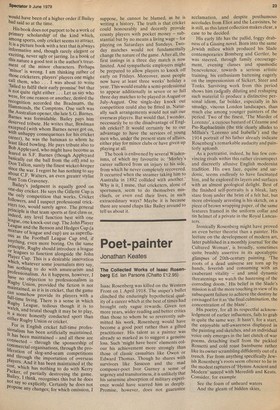Poet-painter
Jonathan Keates
The Collected Works of Isaac Rosenberg Ed. Ian Parsons (Chatto £12.95) Isaac Rosenberg was killed on the Western Front on 1 April 1918. The sniper's bullet clinched the enduringly hypothetical quality of a career which at the best of times had brought only vague rewards. Given ten more years, wider reading and better critics than those to whom he so reverently submitted his work, Rosenberg would have become a good poet rather than a gifted practitioner. His talent as a painter was already so. marked as to suggest a genuine loss. Such 'might have been' elements colour his achievement more strongly than those of classic casualties like Owen or Edward Thomas. Though he shares with survivors like Sassoon and the mad composer-poet Ivor Gurney a sense of urgency and transitoriness, it is unlikely that his saturnine absorption of military experience would have scarred him as deeply. Promise, however, does not guarantee acclamation, and despite posthumous accolades from Eliot and the Leavisites, he is still, as this latest collection makes clear, a case to be decided.
His early life has the pallid, foggy drabness of a Gissing novel. Born into the same _Jewish milieu which produced his Slade contemporaries Bomberg and Gertler, he was steered, through family encouragement, evening classes and spasmodic benevolence, towards a serious artistic training, his enthusiasm battening eagerly on the impressionism of Sickert, Steer and Tonks. Surviving work from this period shows him radtcally diluting and reshaping such material to produce a distinctive personal idiom, far bolder, especially in his smudgy, viscous London landscapes, than much else among younger painters of the period. Two of the finest, 'The Murder of Lorenzo', a curious bastard of Cezanne and Pre-Raphaelitism (the title clearly alludes to Millais's 'Lorenzo and Isabella') and the 1914 portrait of his father already indicate Rosenberg's remarkable audacity and painterly aplomb.
As a portraitist, indeed, he has few convincing rivals within this rather circumspect and discreetly allusive English modernist tradition. His own face, equine and sardonic, seems endlessly to have fascinated him, and he explored its layers and surfaces with an almost geological delight. Best of the finished self-portraits is a bleak, lazy stare fron? under the brim of a felt hat, but more obviously arresting is his sketch, on a piece of brown wrapping paper, of the same features framed in the uniform collar and tin helmet of a private in the Royal Lancasters.
Ironically Rosenberg might have proved an even better theorist than a painter. His lecture on the development of modern art, later published in a monthly journal 'for the Cultured Woman', is broadly, sometimes quite brashly assertive in its apocalyptic glimpses of 20th-century painting. 'The roots of a dead universe are torn up by hands, feverish and consuming with an exuberant vitality — and amid dynamic threatenings we watch the hastening of the corroding doom.' His belief in the Slade's mission is all the more touching in view of its subsequent failure to achieve the destiny he envisaged for it as 'the final culmination, the concentration of the blaze'.
His poetry, for all its respectful acknowledgment of earlier influences, fails to grab in quite the same way. It hasn't, for a start, the enjoyable self-awareness displayed in the painting and sketches, and an individual voice only emerges in the last clutch of war poems, detaching itself from the pickled Rossetti and cold roast Swinburne rather like its owner scrambling diffidently out of a trench. Far from anything specifically Jewish Rosenberg's roots seem oftener to lie in the modest raptures of 'Hymns Ancient and Modern' sauced with Meredith and Keats. Consider, for example See the foam of unheard waters And the gleam of hidden skies, Footsteps of Eve's whiter daughters Flash between our dreaming eyes.
Blake, whom he admired as a draughtsman, figures more strongly as an inspiration for the later poetry, and its refined brevities plainly owe something to the author's acceptance of criticism from the contemporary literati to whom he had begun to send his work. As his latest editor points out, it is doubtful if such panjandrums as Lascelles Abercrombie, Laurence Binyon, Edward Marsh or Gordon Bottomley (none of them, in any case, names of magical resonance) could ever really appreciate the impulsiveness and honesty of Rosenberg's writing, but at any rate their attention, if at times somewhat loftily given, made him readier to prune and select.
The editor makes a justifiable plea for differentiating Rosenberg from Owen and others to be lumped together in anthologies of 'War Poets'. Despite their subject matter, poems like 'Louse Hunting', 'Troop Ship' and 'Dead Man's Dump' convey a kind of bemused interest in the minutiae of action and the beauty of well-composed scenes, with the poet as onlooker rather than participant. In support of this Parsons quotes 'Girl To A Soldier On Leave', but even here awkward diction spoils the effect through Rosenberg's irritating repetition of the word `gyves', with its overtones of Nineties preciosity.
That he had nearly, but not quite, achieved that mastery of verbal resource which characterizes most of Owen and the best of Sassoon is apparent from the verse drama 'Moses', written in 1915. Justly admired by friends and critics, it has a commanding discipline and energy lacking elsewhere in Rosenberg's work, and its weird, oblique utterances bring it closer, in originality of design, to his best paintings. The characters are thinly veiled Edward ians and the overseer Abinoah becomes a Jew-hater in the typical ChesterBelloc mould.
Thus the case, for the time being, rests, but this new edition, by bringing together all the existing fragments of poetry, surviving paintings and the complete letters, makes Rosenberg, quietly stolid, reflective and courageous, a figure of more than passing historical interest, redeemed at last from footnotes and anthologies and given the full perspective he deserves.











































 Previous page
Previous page